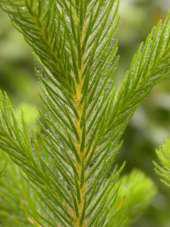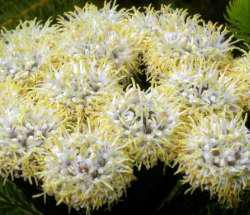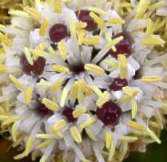Berzelia albiflora
Berzelia albiflora (E.Phillips) Class.-Bockh. & E.G.H.Oliv.( = Brunia albiflora E.Phillips)
Family: Bruniaceae
Common names: coffee-scented berzelia, coffee bush, white-flowered brunia (Eng.); knopbossie, fonteinbossie, stompies (Afr.)
Introduction
Whenever this beautiful shrub is placed on our specimen table, it is often greeted with surprise as if it has never been seen before. It is easy to overlook, even when it is in flower, because it grows tall and presents its lovely white flowerheads above our heads. This plant was previously known as Brunia albiflora.

Description
Description
Berzelia albiflora is a tall, slender, single-stemmed but well-branched shrub, reaching 2-3 m in height. The long, slender branches are densely leafy, with beautiful dark green foliage that resembles a pine tree, but is much softer. The leaves are 10-14 mm long and narrow (0.7mm diameter), narrowly lanceolate to linear, black-tipped, and covered with delicate hairs.

The flowers are tiny, and are crowded into tight spherical knob-like inflorescences (± 15 mm wide) that are clustered into flat, rounded heads. The knobby inflorescences are covered by scale-like leaves, and before the white flowers break through, they are green touched with black and silver, and are also very decorative. Each tiny flower is about 7 mm long, white with yellow stamens sticking out, giving the inflorescence a yellowish tinge. They open in a ring, starting at the outside and working inwards, and age to a creamy yellow. In the early part of the season, one bush usually shows the whole range of silver buds, ringed inflorescence, full and ageing flowers. They are particularly noticeable on overcast days when their white flowerheads seem to gleam amongst the dark green foliage.

After flowering and fertilization, the flowers turn brown and drop off. The knobby infructescence turns green, ageing to brown in time, and it stays on the bush for up to six years, so the remains of the previous year's flowerheads can be seen lower down on the stem. Flowering time is late summer to autumn (February-April).

Conservation Status
Status
Least Concern. Berzelia albiflora is not threatened.
Distribution and habitat
Distribution description
Berzelia albiflora is endemic to the Western Cape and occurs from the Hottentots Holland Mountains to Hermanus. It has an extensive distribution on the Hottentots Holland Mountains south of Kogelberg, mostly on moist ground or in marshes on peaty sandstone, and is common on the south-eastern slopes at the head of kloofs, usually at an altitude between 330 and 1 000 m.
Derivation of name and historical aspects
History
The previous genus name, Brunia is most likely named after a contemporary of the apothecary Linnaeus, Dr Cornelius Brun, who travelled in Russia and the Levant, although it could also be in commemoration of Dr Alexander Brown, a ship's surgeon and plant collector who worked in the East Indies around 1690. The species name albiflora means white-flowered. The Afrikaans common names are strictly applied to Brunia noduliflora (= B.nodiflora), but are used to refer to this species, some of the berzelias, and other brunias as well. Knopbossie means knob-bush, and refers to the knob-like inflorescences that are a noticeable feature of berzelias and brunias. Fonteinbossie means spring-bush (as in water source), because these plants are often found growing near running water or in the vicinity of a springhead. Stompies means little stumps, and refers to the fact that if a fire sweeps through the population, all that is left are small, blackened stumps.
This family consists of 77 species in 12 genera: Brunia, Berzelia, Nebelia, Staavia, Audouinia, Linconia, Lonchostoma, Mniothamnea, Thamnea, Pseudobaeckea, Tittmannia and Raspalia. Although endemic to southern Africa, it can't be said to be endemic to the Cape Floral Kingdom because three species extend outside the Cape Floristic Region, one as far as southern KwaZulu-Natal. It is a variable family; Audouinia capitata and Tittmannia esterhuyseniae look like ericas, Staavia dodii looks like a daisy, Lonchostoma spp. look like something from the Thymelaeaceae family, Staavia globosa has been mistaken for a phylica, and Linnaeus himself mistook a coneless twig of Widdringtonia as the type specimen for Brunia nodiflora, now B. noduliflora . Those species relatively well known to gardeners or buyers of cut flowers in the Cape are various species of Brunia, Berzelia, Nebelia paleacea and Staavia radiata.
Only about a quarter of the species in this family are locally frequent where they occur, and the rest are rare, often confined to the upper slopes and in isolated patches of a few individuals. Many of the members of this family show a lack of reproductive vigour, and are difficult to propagate from seed and keep alive in cultivation. Research has shown that more than 20% of the pollen grains of the worst offenders show irregular appendages and distortions in shape or a reduction in size, which suggests that they are not viable. It appears that this family is slowly heading towards extinction, not, for once, because of mankind, but because it has reached the end of its natural lifespan and is in a state of senescence.
The family is an ancient family. Actinocalyx bohrii, a fossil flower from the Upper Cretaceous (70-80 million years ago) of southern Sweden, shares many characteristics with the Bruniaceae, which indicates a great age for the ancestral line of this family. Recently, fossil pollen that matches modern Bruniaceae pollen has been found in early Tertiary and late Cretaceous deposits in northern Namaqualand, that is between 65 and 97.5 million years ago, roughly the time between the dinosaurs disappearing and the first primates appearing. This confirms the considerable age of this family in southern Africa. The wood of the Bruniaceae is very primitive, although its other features are not. It has no other close relatives in Africa or on the fragments of Gondwana. The diversity of this family and its limited geographical range suggest that it has been isolated at the southern tip of Africa for a long time. There is no indication where the ancestral stock originated, nor how it got to southern Africa. Its lack of Gondwana relatives could be because it appeared here when the fragments were too far apart to be reached by chance dispersal, or it could be that because this family is in a state of decline, its other relatives have already gone extinct and the southern African members are the only survivors. The Bruniaceae has been placed with the Grubbiaceae (an endemic Cape family) near the order Ericales. It is now thought to be a sister group to the order Dipsacales, including the Dipsacaceae (teasel and scabiosa family); the two groups are thought to have diverged around 57 million years ago.
Ecology
Ecology
Berzelia albiflora flowers provide both nectar and pollen. Pollen is not produced in the same abundance as a wind-pollinated shrub, but if you touch a flowerhead, you will get pollen on you, and if you look closely at the flowers you can see that a drop of nectar forms at the base of each flower. These look like blobs of shiny purple gum, but are in fact drops of sweet liquid. I have seen sunbirds, bees, a few beetles, ants and a wasp visit the flowers at Kirstenbosch; the sunbirds were the most industrious, standing on a flowerhead while probing the flowers for nectar and moving from one flowerhead to the next.

Berzelia albiflora is serotinous, i.e. it stores its seeds and accumulates them annually, and they are released after the parent plant is killed by fire. The garden at Kirstenbosch is not burnt, so the infructescence eventually disintegrates and the seeds fall to the floor below the parent. Some of the seeds germinate on their own, so although they are adapted to a fire-prone vegetation and germinate much better after a fire, they are not entirely dependant on fire for regeneration.
Uses
Use
Berzelia albiflora is a lovely cut flower, and an excellent filler. Just the green stems can be cut as foliage, or the inflorescences can be cut at whatever stage the beholder considers them to be attractive! As it is a tall plant, long stems are easily achieved.
Because it is such a good green filler, B. albiflora is harvested, sometimes quite aggressively, from farms in its distribution range. A study by Rebelo & Holmes (1990) showed that populations that were heavily plucked, i.e. had more than 90% of their foliage removed, had no seed reserves so that the populations were unlikely to recover if burnt. Furthermore, plants that were heavily plucked could be killed. In some cases up to 50% of them died, although in a well-managed population, only 8% died during the study period. Berzelia albiflora seems unable to regenerate from old wood that has lost its leaves. Therefore, if a branch is cut off below the lowest leaf-bearing shoot, that branch will die. In cases where a plant is still young and consists of a single leader, cutting below the leaf-line will kill the whole plant. To manage populations in a sustainable manner, cut-flower producers should ensure that they never remove more than 80% of all flowerheads, and do not cut below the leaf-line; also, if the previous year's seeds are removed, they should be stored and not discarded. In this way the seed can be replaced in the event of a fire.
Growing Berzelia albiflora
Grow
Treat Berzeliaalbiflora like a typical fynbos plant, e.g. protea, pincushion or conebush, and you should have success with it. Grow it in well-drained, acidic soil, in a sunny position, water it well, particularly in winter, and make sure that excess water drains away. Do not use strong chemical fertilisers or manure. It is probably tender to frost, but should survive the odd cold snap of 0 to -1°C.

Propagate Berzelia albiflora by seed sown in autumn. Seed of Berzelia albiflora has a naturally low percentage germination, but being a fire-adapted plant, treating the seed with the Kirstenbosch Instant Smoke Plus Seed Primer shows a marked improvement in the number of healthy seedlings. Seed should be harvested from the previous year's flowers. Use a well-drained, acidic medium suitable for fynbos plants, e.g. roughly equal parts river sand and decomposed pine bark or well-rotted, manure-free compost and about 20% topsoil. Cover the seeds lightly with the sowing medium, and water gently to avoid disturbing the seeds. Keep moist but not wet. The seeds should start to germinate in about six weeks. The young seedlings are very small and delicate and need to be nursed through their first year. Place the tray(s) in good bright light but not in direct sun, e.g. under an opaque roof or shade-netting and in a well-ventilated area. Water by hand, and keep the medium well-watered but take care not to over-water. The seedlings grow slowly during winter and only start to increase in size as spring approaches. They can be potted up in spring, but only if they are between 10-20 mm tall and have developed their secondary leaves. Pot them into small pots or multi-trays; they often die when placed in large containers, probably because the soil remains too wet. Use the same fynbos mix that was used for the seed. Feed the seedlings every two weeks with a diluted, liquid, seaweed-based fertilizer. Keep them in the nursery all summer in the same conditions, i.e. bright light but not direct sun, and well ventilated. They can be placed in a larger container, or planted out into the garden the following autumn. Regular pruning or pinching out the shoots will result in increased branching and a more rounded bush with more flowers; remember not to prune below the leaf-line.
Berzelia albiflora can also be propagated vegetatively. Cuttings should be taken in autumn or spring from actively growing, healthy shoots. The best results are achieved from side shoots not longer than 100 mm, taken as heel cuttings. Tip cuttings can also be taken. Gently remove the needle-like leaves from the lower 20-30 mm of the cutting and dip the heel or cut end in a rooting hormone used for semi-hardwood cuttings. You can use a powder or liquid rooting hormone. Place the cuttings in a rooting medium consisting of equal parts of 6 mm milled pine bark and polystyrene balls. The polystyrene aerates the mix, which is crucial for healthy root development. Some growers have had success using washed peat and coarse riversand. Use a shallow or compartmentalised tray for the cuttings, and make sure that the cleaned stem is submerged in the medium. Place the trays where they will receive regular misting or fogging; this prevents the leaves from drying out. Heated benches are also recommended as the warmth accelerates the rooting process. Rooting takes from six weeks to a few months. We have found that some cuttings do not develop roots, even after a few months. Instead we find white cell aggregations on the lower stem. This is callus tissue, which may not produce roots. We remove these cuttings and slightly damage the ends, then re-treat them with rooting hormone and place them into fresh rooting medium and have had good results with roots developing rapidly and aggressively.
The roots are fine and delicate, so rooted cuttings should be carefully removed and transplanted into individual containers. Use a well-drained, acidic mix suitable for fynbos plants. Place the newly rooted cuttings in a cool, shaded, well-aerated spot for them to adapt to their new medium. Feed them regularly with diluted organic fertilizer. When they are actively growing, place them in full sunlight.
Reader's Comment:
In October 2012 Terrence Beavis wrote: I am resident in Blenheim New Zealand. I have read about Brunia Albiflora on the website " Plantzafrica.com". I note on the website that Brunia will tolerate temperatures down to -1 degrees. I have three Brunia Albiflora growing in my garden here and have had temperatures down to -8 degrees of frost with no damage to foliage or flowers.
References
- Dyer, R.A. 1944. Brunia albiflora. The Flowering Plants of South Africa 24: t. 928
- Goldblatt, P. & Manning, J. 2000. Cape plants, A conspectus of the Cape flora of South Africa. Strelitzia 9. National Botanical Institute, Pretoria & Missouri Botanical Garden Press.
- Goldblatt, P. & Manning, J.C. 2002. Plant diversity of the Cape Region of southern Africa. Annals of the Missouri Botanical Garden 89: 281-302.
- Hall, A.V. 1987. Evidence of a Cretaceous alliance for the Bruniaceae. South African Journal of Science 83: 58, 59.
- Jackson, W.P.U. 1990. Origins and meanings of names of South African plant genera. University of Cape Town Printing Department.
- Plants of southern Africa: an online checklist. http://posa.sanbi.org
- Rebelo, A.G. & Holmes, P.M. 1990. Reap or rape? Exploitation of the coffee bush Brunia albiflora. Veld & Flora 76: 45-47.
- Scott, G. 1989. Bravo for the Bruniaceae. Veld & Flora 75: 105, 106.
- Smith, C.A. 1966. Common names of South African plants. Memoirs of the Botanical Survey of South Africa No 35.
Credits
Alice Notten
(Propagation information provided by Anthony Hitchcock)
Kirstenbosch National Botanical Garden
April 2004
(Updated February 2010)
Plant Attributes:
Plant Type: Shrub
SA Distribution: Western Cape
Soil type: Sandy
Flowering season: Late Summer, Autumn
PH: Acid
Flower colour: White, Cream
Aspect: Full Sun, Morning Sun (Semi Shade)
Gardening skill: Challenging
Special Features:
Horticultural zones










Rate this article
Article well written and informative
Rate this plant
Is this an interesting plant?
Login to add your Comment
Back to topNot registered yet? Click here to register.